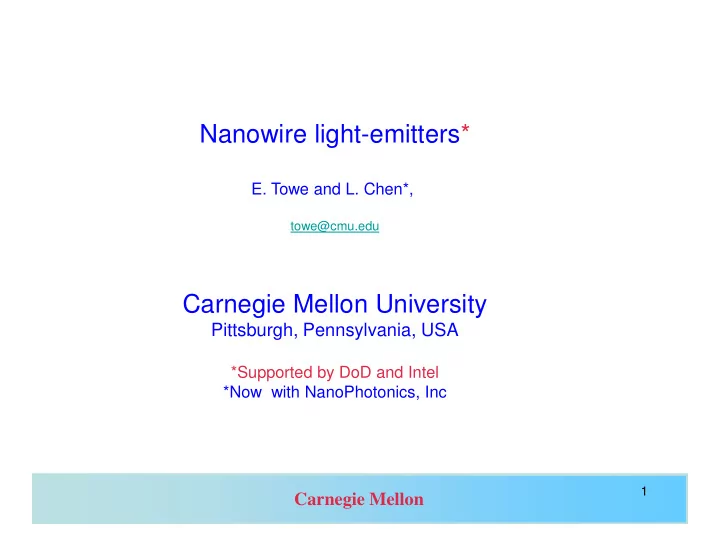

Nanowire light-emitters* E. Towe and L. Chen*, towe@cmu.edu Carnegie Mellon University Pittsburgh, Pennsylvania, USA *Supported by DoD and Intel *Now with NanoPhotonics, Inc 1 Carnegie Mellon
Outline • Some background on light-emitters; • Nanowire light-emitters; • Proposed improvements on nanowire light- emitters; • Summary 2 Carnegie Mellon
One of the problems with photonics Most important component is hard to integrate and scale 3 Carnegie Mellon
Some progress with the vertical-cavity laser Oxide Layer Large numbers of VCSELs can be manufactured using batch techniques; but integration with other devices is still not a routine process. Active 4 Carnegie Mellon
Active photonic device scaling: the nanowire emitter Optically pumped ZnO nanowire emiters with diameters from 20 – 150 nm, and lengths ~10 um. Huang, Mao, Feick, Yan, Wu, Kind, Weber, Russo, Yang, Science 292 1897 (2001). 5 Carnegie Mellon
A computational model for understanding nano-emitters • Coupled carrier-transport and photon-generation rate equations; • FDTD method for allowed modal solutions and field profiles; field profiles; • Include coupling of spontaneous emission into the lasing modes (size effect); • Model should be self-consistent. 6 Carnegie Mellon
The parameter space for a laser Carrier Carrier Carrier Carrier Carrier-Photon Carrier-Photon Carrier-Photon Carrier-Photon Transport Transport Transport Transport Interaction Interaction Interaction Interaction Poisson’s EQ Possion’s EQ Possion’s EQ Possion’s EQ Schrödinger's EQ Schrodinger EQ Schrodinger EQ Schrodinger EQ Continuity EQs Continuity EQs Continuity EQs Continuity EQs Semiconductor laser Semiconductor laser Semiconductor laser simulation simulation simulation simulation simulation simulation Optical field Optical field Optical field Optical field propagation propagation propagation propagation Heat transfer Heat transfer Heat transfer Heat transfer Maxwell EQs Maxwell’s EQs Maxwell EQs Maxwell EQs Thermdynamic EQs Thermdynamic EQs Thermdynamic EQs Thermdynamic EQs Device equations governing semiconducto Device equations governing semiconductor lasers 7 Carnegie Mellon
Coupled opto-electronic qquations Carrier Transport Equations (Local) ( + − ) ( ) − ∇ ⋅ − ε 0 ε ∇ ψ = − + q p n N N static D A � ψ -- electrostatic potential ( ) ∇ ⋅ = − − − − − R R J q G R R n, p – electron, hole concentrations n au SRH sp st J n , J p -- current densities � S m -- Photon density of m th mode ( ) ∇ ⋅ = − − − − R R J q G R R sp st p au SRH � G -- carrier generation rate = ∇ − µ ∇ ψ J qD n q n n n n R -- carrier recombination rates � D -- diffusion coefficient = − ∇ − µ ∇ ψ J qD p q p � -- mobility p p p Photon Rate Equation (Global) (Global) (Global) (Global) G m -- modal gain calculated from local gain S τ opt -- photon life time m − + β = G S R 0 m sp, total β m � -- spontaneous emission factor opt R sp,total -- total spontaneous emission rate 8 Carnegie Mellon
Calculated light output and spectra for a GaN nanowire light-emitter 9 Carnegie Mellon
Calculated output-input characteristics for GaN nanowire emitters for various important parameters 10 Carnegie Mellon
Challenges of small emitters • Usually insufficient material gain; • Very lossy (large mirror and diffractive losses); • Severe mode competition for the little gain; • Difficult to integrate with electrical pumping schemes; • Large surface/volume rations => surface recombination problems . 11 Carnegie Mellon
Proposal: use distributed Bragg reflectors or 1-D photonic crystals in nanowires • Distributed Bragg reflectors have been successfully used in lasers before; • Growth of nanowire heterostructures has been demonstrated: demonstrated: – scale the heterostructures to DBR mirrror pairs; – calculate properties of DBR structures; • end mirror properties • photonic crystal properties 12 Carnegie Mellon
Nanowires and heterostructures InAs/InP heterostructures Bjork, Ohlsson, Sass, Persson, Samuelson Nano Lett. 2 No. 2, 87-89 (2002). 13 Carnegie Mellon
Proposal for a better nanowire laser: the superlattice photonic crystal structure Chen and Towe, Appl. Phys. Lett. , 87 103111 (2005). 14 Carnegie Mellon
Defect mode spectral location and reflectivity of a nanowire superlattice laser cavity Chen and Towe, Appl. Phys. Lett. , 87 103111 (2005). 15 Carnegie Mellon
Calculated output-input characteristics and emitting spectra of a superlattice nanowire 16 Carnegie Mellon
n = 2.55, radius = R n = 2.30, radius = R i = 0.5R 17 Carnegie Mellon
18 Carnegie Mellon
19 Carnegie Mellon
20 Carnegie Mellon
21 Carnegie Mellon
Summary • Interaction of light with size-dependent effects in nanostructures offer device design opportunities for next-generation optoelectronics devices; • Most significant impact will likely be in components that • Most significant impact will likely be in components that offer ease of integration with other devices; • Integration with electronics will probably mean having to deal with heterogeneous integration technologies. 22 Carnegie Mellon
Recommend
More recommend